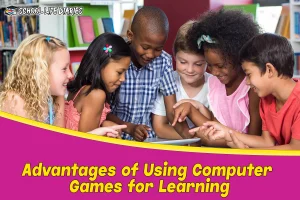In today’s digital age, integrating technology into the classroom has become essential for fostering interactive and engaging learning experiences. Games to play in class on a computer provide an excellent way to combine education and entertainment, capturing students’ attention and enhancing their understanding of various subjects. In this article, we will explore a variety of exciting computer games that cater to different age groups and subjects, creating an enriching environment where students can thrive.
Games to Play in Class on Computer
- Math Mania: Make math enjoyable with Math Mania, a thrilling game that challenges students to solve mathematical problems while navigating through a virtual maze. LSI Keywords: math games for students, educational math games. Math Mania engages students’ problem-solving skills and boosts their confidence in tackling arithmetic operations.
- Word Wizardry: Enhance vocabulary and language proficiency with Word Wizardry, an interactive word puzzle game. LSI Keywords: language learning games, vocabulary building games. Students can have a blast while broadening their lexicon and honing their linguistic abilities.
- Historical Hunts: Step into the shoes of a detective and explore history through immersive storytelling and puzzles. LSI Keywords: history educational games, historical adventure games. Historical Hunts spark curiosity about the past, making learning history an exciting journey.
- Science Sleuths: Unleash the inner scientist with Science Sleuths, an investigation-based game exploring various scientific concepts. LSI Keywords: science educational games, STEM learning games. Students get hands-on experience with scientific processes, fostering a deeper understanding of core concepts.
- Geography Explorers: Embark on a virtual journey around the world, discovering continents, countries, and cultures. LSI Keywords: geography games for students, world map exploration games. Geography Explorers instill a global perspective and appreciation for diversity.
The Power of Gamification in Education
Integrating games into the classroom setting, commonly known as gamification, holds numerous benefits for students. By introducing gamified learning experiences, educators can:
- Foster Active Learning: Games encourage students to actively participate, allowing them to learn by doing rather than passively receiving information.
- Enhance Problem-Solving Skills: Many educational games present challenges and puzzles that require critical thinking, stimulating students’ problem-solving abilities.
- Increase Engagement: The interactive nature of games captivates students’ attention, keeping them focused on the learning material.
- Promote Collaboration: Certain multiplayer games encourage teamwork and collaboration, fostering a sense of camaraderie among students.
- Provide Immediate Feedback: Games often offer real-time feedback, enabling students to identify and correct their mistakes instantly.
Best Practices for Incorporating Games into the Classroom
To ensure successful integration of games in the classroom, educators should consider the following best practices:
- Align Games with Learning Objectives: Choose games that align with the curriculum and target specific learning outcomes.
- Provide Clear Instructions: Before starting the game, explain the rules and objectives to the students, ensuring they understand how to play.
- Monitor Progress: Track students’ progress in the game to identify areas where they may need additional support.
- Encourage Reflection: After playing the game, engage students in discussions about their experiences and what they’ve learned.
- Balance with Traditional Teaching: While games are valuable learning tools, they should complement traditional teaching methods rather than replace them entirely.
Advantages of Using Computer Games for Learning
Computer games have revolutionized the way we learn and teach, bringing numerous benefits to students and educators alike. Incorporating computer games into the learning process can enhance engagement, boost retention, and promote critical thinking. Here are some of the key advantages of using computer games for learning:
- Interactive Learning Experience: Computer games provide an interactive learning experience that actively involves students in the educational process. Unlike traditional passive learning methods, games require students to make decisions, solve problems, and engage actively with the content.
- Engagement and Motivation: Educational computer games are designed to be fun and captivating. They capture students’ attention and keep them motivated to progress further in the game. This high level of engagement can lead to increased interest in the subject matter.
- Immediate Feedback: Computer games often provide instant feedback to students. Whether it’s solving a math problem or answering a historical question, students receive immediate feedback on their performance. This allows them to learn from their mistakes and improve their skills in real time.
- Adaptability and Personalization: Many educational games come with adaptive features that adjust the difficulty level based on a student’s performance. This personalized approach ensures that each student is appropriately challenged and can learn at their own pace.
- Learning by Doing: In computer games, students learn by doing. This hands-on approach allows them to experiment, take risks, and see the consequences of their actions, fostering deeper understanding and long-term retention of concepts.
- Collaborative Learning Opportunities: Some computer games offer multiplayer options, enabling students to collaborate with their peers. Working together to achieve a common goal enhances teamwork and communication skills.
- Visualization of Abstract Concepts: Complex and abstract concepts can be challenging to understand through traditional teaching methods alone. Computer games often incorporate visual elements and simulations, making it easier for students to grasp such concepts.
- Cross-Curricular Learning: Many computer games span multiple subjects, allowing students to explore connections between different topics. This interdisciplinary approach promotes a holistic understanding of knowledge.
- Accessible Anytime, Anywhere: With the advent of mobile devices, educational games can be accessed anytime and anywhere. This flexibility empowers students to continue their learning beyond the classroom.
- Reduction of Test Anxiety: Computer games present learning as an enjoyable experience, reducing the anxiety often associated with traditional testing. Students can demonstrate their knowledge through gameplay rather than standard assessments.
- Encouragement of Creativity: Some computer games encourage creativity and problem-solving skills by giving students the freedom to create, design, and experiment.
- Inclusivity for Different Learning Styles: Educational games cater to various learning styles, ensuring that visual, auditory, and kinesthetic learners can all benefit from the interactive experience.
- Long-Term Skill Development: Through regular practice and repetition, computer games can help students develop essential skills such as critical thinking, decision-making, and adaptability.
- Continuous Progress Tracking: Teachers can monitor students’ progress in educational games, identifying strengths and weaknesses to provide targeted support.
- Bridging the Generation Gap: As digital natives, many students feel comfortable navigating technology. Educational computer games can bridge the generation gap and facilitate communication between students and educators.
Frequently Asked Questions (FAQs)
Q: Are these games suitable for all age groups?
A: Yes, the games mentioned in this article are designed for various age groups, from elementary to high school students. Some may require more advanced skills, but there are options suitable for all.
Q: Can these games be accessed on different devices?
A: Many educational games mentioned here are designed to be accessible on computers, tablets, and even smartphones, making them flexible and convenient for classroom use.
Q: Are these games aligned with educational standards?
A: Absolutely! The games recommended in this article are carefully curated to align with educational standards and learning objectives, ensuring they contribute to academic growth.
Q: How can I integrate these games into my lesson plans?
A: You can integrate these games as supplementary activities or as a way to reinforce specific concepts taught in class. Simply align the game with your lesson’s objectives and let students explore.
Q: Are there multiplayer options available for collaborative learning?
A: Yes, several games mentioned in this article offer multiplayer features, promoting collaborative learning experiences among students.
Q: Can I track my student’s progress in these games?
A: Yes, many educational games come with progress-tracking features, allowing you to monitor individual students’ performance and identify areas of improvement.
Conclusion: Games to Play in Class on Computer
Incorporating games to play in class on a computer is a fantastic way to create a dynamic and enjoyable learning environment. By leveraging the power of gamification, educators can boost engagement, stimulate critical thinking, and facilitate a deeper understanding of various subjects. From math challenges to historical adventures and scientific exploration, the games mentioned in this article offer diverse options for enhancing the classroom experience.








